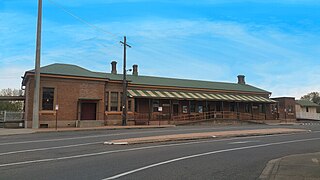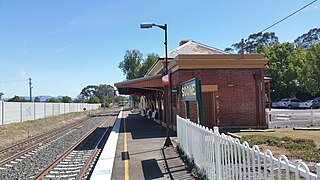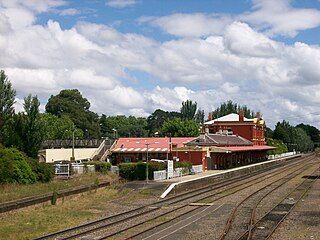
Singleton railway station is a heritage-listed railway station located on the Main Northern line in New South Wales, Australia. It serves the town of Singleton. It was added to the New South Wales State Heritage Register on 2 April 1999.

Scone railway station is a heritage-listed railway station located on the Main Northern line in Scone, in the Upper Hunter Shire local government area of New South Wales, Australia. The station serves the town of Scone and opened on 17 April 1871. The property was added to the New South Wales State Heritage Register on 2 April 1999.

Mittagong railway station is a heritage-listed railway station on the Main Southern line in New South Wales, Australia. It serves the town of Mittagong in the Southern Highlands. It was added to the New South Wales State Heritage Register on 2 April 1999.

Moss Vale railway station is a heritage-listed railway station on the Main Southern line in New South Wales, Australia. It serves the town of Moss Vale. It opened on 2 December 1867 as Sutton Forest, being renamed in 1877. It was added to the New South Wales State Heritage Register on 2 April 1999.

Bundanoon railway station is a heritage-listed railway station on the Main Southern line in New South Wales, Australia. It serves the small town of Bundanoon. It was added to the New South Wales State Heritage Register on 2 April 1999.

Tallong railway station is a heritage-listed railway station located on the Main Southern line in New South Wales, Australia. It serves the village of Tallong, opening in 1869 as a small halt named Barbers Creek Tank. A platform was opened on 16 April 1878 and it was renamed Tallong on 6 April 1905. It was added to the New South Wales State Heritage Register on 2 April 1999.

Marulan railway station is a heritage-listed railway station located on the Main Southern line in New South Wales, Australia. It serves the town of Marulan. It opened on 6 August 1868. It was added to the New South Wales State Heritage Register on 2 April 1999.

Albury railway station is a heritage-listed railway station at Railway Place, Albury, New South Wales, Australia, adjacent to the border with Victoria, in Australia. It was designed under the direction of John Whitton and built from 1880 to 1881. It was added to the New South Wales State Heritage Register in 1999.

Rosewood is a village community and locality in the southeast part of the Riverina, New South Wales, Australia. It is situated about 16 kilometres (9.9 mi) southeast from Carabost and 19 kilometres (12 mi) northwest from Tumbarumba. At the 2016 census, Rosewood had a population of 214. The village is administered by two local governments; the northern part of the locality by the Greater Hume Shire and the southern part of the locality by the Snowy Valleys Council. The village of Rosewood is within the Snowy Valleys Council area.

Culcairn railway station is a heritage-listed railway station located on the Main Southern line in New South Wales, Australia. It serves the town of Culcairn. It was added to the New South Wales State Heritage Register on 2 April 1999.

Henty railway station is a heritage-listed railway station located on the Main Southern line in New South Wales, Australia. It serves the town of Henty. It was added to the New South Wales State Heritage Register on 2 April 1999.

The Rock railway station is a heritage-listed railway station and antique shop located on the Main Southern line in The Rock in the Lockhart Shire local government area of New South Wales, Australia. The station is also known as The Rock Station and yard group. The property was added to the New South Wales State Heritage Register on 2 April 1999.

Cootamundra railway station is located on the Main Southern line in New South Wales, Australia. It serves the town of Cootamundra. The property was added to the New South Wales State Heritage Register on 2 April 1999.

Casino railway station is a heritage-listed railway station on the North Coast line in New South Wales, Australia. Opening on 22 September 1930, it serves the town of Casino in the Richmond Valley Shire. It was added to the New South Wales State Heritage Register on 2 April 1999.

Broken Hill railway station is a heritage-listed railway station located on the Broken Hill line in Broken Hill, New South Wales, Australia. It was added to the New South Wales State Heritage Register on 2 April 1999.

Taree railway station is located on the North Coast line in New South Wales, Australia. It serves the town of Taree, opening on 5 February 1913 when the line was extended from Dungog. It was the terminus of the line until it was extended to Wauchope on 12 April 1915. It had extensive locomotive servicing facilities, including an eight road roundhouse. It was added to the New South Wales State Heritage Register on 2 April 1999.

Blayney railway station is a heritage-listed railway station on the Main Western line in Blayney, Blayney Shire, New South Wales, Australia. The property was added to the New South Wales State Heritage Register on 2 April 1999.

Murrurundi railway station is a heritage-listed railway station located on the Main Northern line in Murrurundi in the Upper Hunter Shire local government area of New South Wales, Australia. It was built between 1872 and 1917. It is also known as Murrurundi Railway Station group. The station serves the town of Murrurundi and opened on 4 April 1872. The station served as the terminus of the line until it was extended to Quirindi on 13 August 1877. The station was added to the New South Wales State Heritage Register on 2 April 1999.

Tarana railway station is a heritage-listed railway station located on the Main Western line in Tarana, City of Lithgow, New South Wales, Australia. It is also known as the Tarana Railway Station and yard group. The property was added to the New South Wales State Heritage Register on 2 April 1999.

Narrandera railway station is a heritage-listed railway station located at Whitton Street, Narrandera, Narrandera Shire, New South Wales, Australia. It is situated on the Hay railway line, and was formerly the junction station for the Tocumwal railway line. It was built in 1880 by Charles Hardy to a design attributed to John Whitton. The property was added to the New South Wales State Heritage Register on 2 April 1999.






















